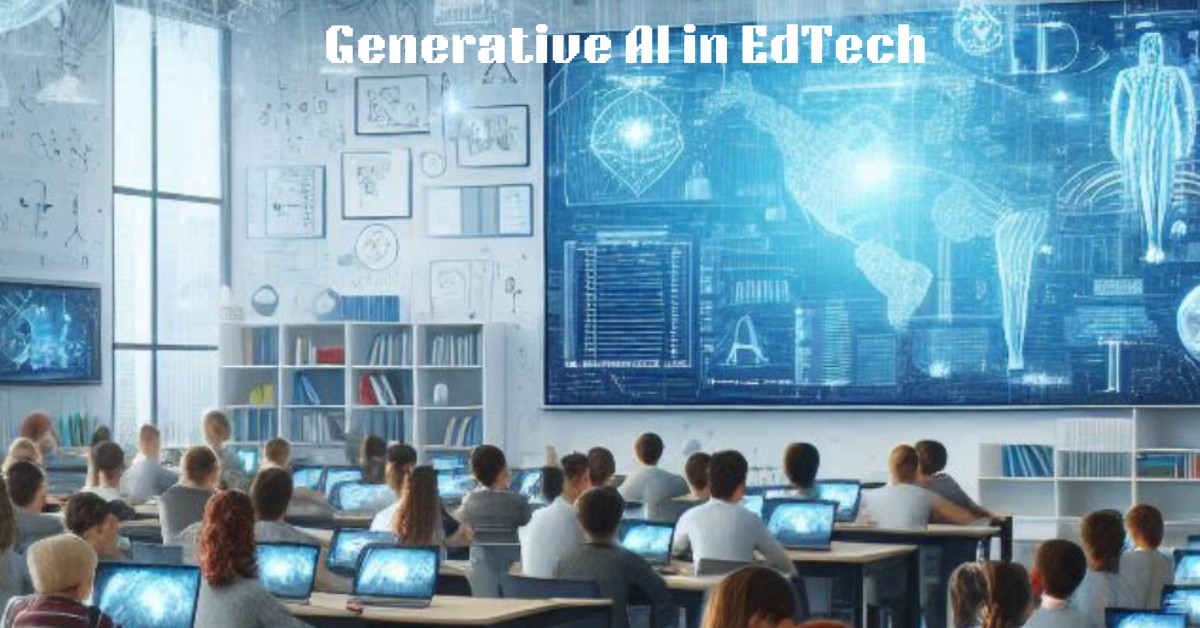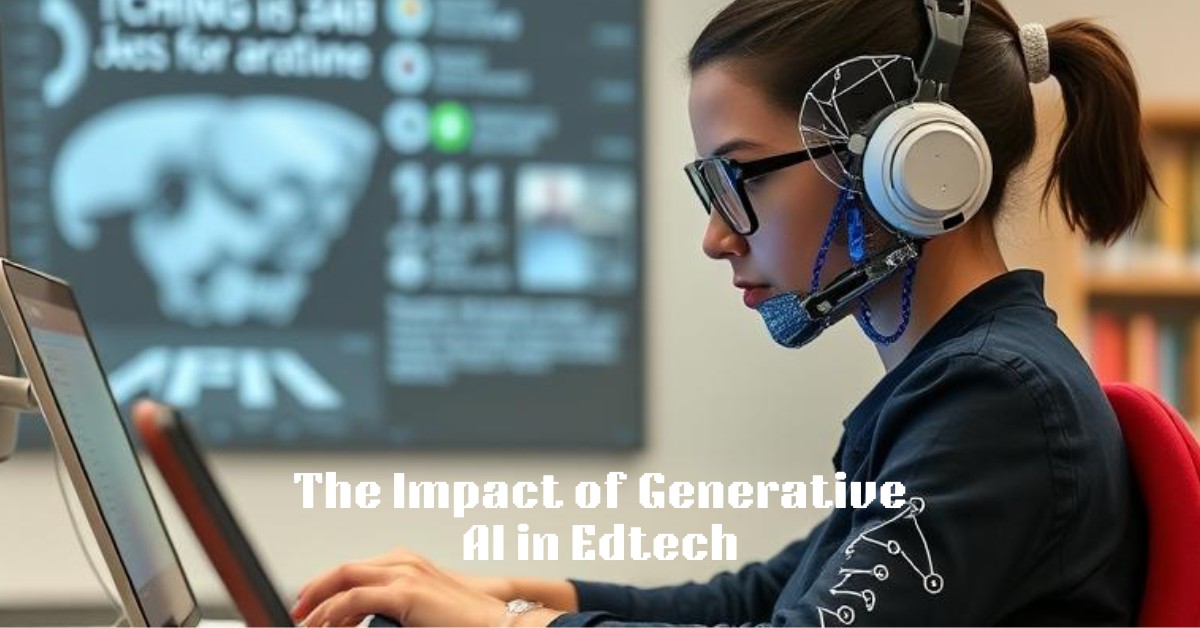
Generative AI in EdTech
What is Generative AI ?
Generative artificial intelligence is a type of AI that uses patterns found in existing data to produce new content, such as text, images, code, or audio. However, generative AI is able to generate creative outputs that are similar to those produced by humans, while traditional AI systems are restricted to obeying preprogrammed rules. Numerous industries, including healthcare, marketing, and even education, use this area of artificial intelligence extensively.
The Role of Generative AI in EdTech
The education technology (EdTech) sector might undergo a dramatic transformation because of generative AI. Generative AI is used in EdTech to customize learning, dynamically adjust information, and automate time-consuming operations like lesson planning and assignment marking that are typically performed by teachers. Additionally, it gives students access to a more customized learning environment, which improves the effectiveness and engagement of education.
Global Importance of Generative AI in EdTech
The use of AI in education is expanding quickly, particularly in countries like the USA and India. Schools and platforms in the United States have been early adopters, but India, with its sizable student population, is catching up swiftly. AI-powered technologies are being integrated by Indian platforms such as “Vedantu” and “Unacademy” to provide individualized education to millions of students. Adaptive learning methods are being used by US-based platforms like “DreamBox Learning” to improve student outcomes. AI tackles a number of issues related to education in both nations, such as developing customized Curriculum, increasing student involvement, and facilitating underprivileged groups’ access to educational resources.
In remote and hybrid learning contexts, generative AI technologies are becoming more and more important, opening up access to top-notch education everywhere, regardless of one’s physical location. As both regions engage in scalable EdTech solutions, this trend is probably going to continue.

The Impact of Generative AI in Edtech
1. Transforming the Classroom Experience
Learning is becoming more individualized and participatory thanks to generative AI, which is completely changing the typical classroom environment. AI-powered platforms enable educators to provide dynamic lessons catered to the skills and pace of each student. Adaptive algorithms are used in the US by programs like “DreamBox Learning” to improve student performance, especially in K–12 math education. In the meantime, AI is being used in India through Edtech startups such as “Vedantu” and “Unacademy” to offer real-time, individualized coaching. This has shown to be particularly helpful in reaching students who live in remote or underdeveloped areas.
2. Personalized Learning at Scale
Generative AI’s capacity to provide individualized learning experiences is among its most important educational accomplishments. AI modifies lesson plans, homework assignments, and even tests according to each student’s performance indicators in real time. By addressing their areas of difficulty and highlighting their strengths, this approach guarantees that every student may study at their own speed. Artificial Intelligence (AI) enhances student learning results through personalized study materials, automatically created quizzes, and real-time feedback.
Case Study: Vedantu (India)
With the help of artificial intelligence (AI), Vedantu offers live, interactive classes that provide individualized learning routes by instantly adapting to the responses of the students. Additionally, the platform provides data driven by AI, which aids educators in concentrating on their areas of weakness.
Case Study:DreamBox Learning (US):
DreamBox Learning is an AI-driven math platform that dynamically adjusts information according to student input, resulting in enhanced problem-solving abilities and superior academic outcomes. Students utilizing DreamBox for as little as 60 minutes a week boosted their arithmetic scores dramatically, according to a US K–12 research.
3. Increased Involvement of Students
By fostering more dynamic and engaging learning environments, AI tools aim to raise student engagement. AI is also being used to construct environments and simulations that aid in the better understanding of difficult subjects by pupils through the use of augmented reality (AR) and virtual reality (VR). These tools improve student engagement by increasing the visual and tactile aspects of learning.
Case Study: AI in Science Education
AI-powered simulations in biology or chemistry allow students to experiment in virtual labs, providing a more interactive way to learn complex scientific concepts. This also makes learning more accessible to students who may not have access to physical lab resources, which is particularly relevant in countries like India.
Top Generative AI Tools in Edtech
Several generative AI tools have become indispensable in modern education, offering everything from personalized content to automated grading systems. Here’s an overview of some of the most prominent tools in both the US and India:
1. DreamBox Learning(US): Specializes in adaptive math lessons for K-12 students, using AI to create personalized learning pathways.
2. Vedantu (India): Offers live tutoring and uses AI to generate personalized progress reports and learning paths for students.
3. Unacademy (India): Provides AI-powered content suggestions and personalized courses to improve student learning outcomes.
4. Content Technologies, Inc.: Uses AI to generate custom textbooks tailored to individual learning needs.
5. Squirrel AI (China): A leader in AI-powered personalized learning systems, focusing on adaptive tutoring for different subjects.
Benefits of Generative AI in Edtech
Numerous benefits provided by generative AI are changing the face of education:
1. Personalized Learning: AI customizes course material to meet the needs of each learner, improving academic achievement.
2. Improved Content Creation: AI facilitates the large-scale production of specialized study guides, tests, and classes.
3. Better Student Engagement: Students maintain motivation and focus in AI-driven interactive environments.
4. Curriculum Development: Educators can modify the curriculum with data-supported modifications thanks to AI-driven insights.
5. Enhanced Access: AI lowers expenses and provides education to underprivileged and remote places.
Key Points:
Learning pathways that are adaptive and customized for each student.
Time-saving for teachers through automated assessment and grading.
AI-powered resources that increase participation include virtual labs and simulations.
Access to affordable education via platforms driven by AI.

Challenges and Ethical Considerations of Generative AI
Although generative AI has numerous advantages, there are drawbacks as well:
2. Data Privacy Concerns: How sensitive student data is collected, maintained, and used for AI purposes raises privacy concerns.
3. Teacher Dependency: If AI is used excessively, teachers’ duties may be reduced, which calls into question the value of human connection in the classroom.
Key Points:
The potential for AI results in reinforcing biases.
Privacy issues with the gathering of student data.
Harmonizing AI and human engagement in the classroom.
Real-time Data on AI Adoption in EdTech
The integration of AI in education is growing across the globe. Here are some real-time insights into the adoption rates of AI in the US and India:
In the US: Over 47% of schools have adopted AI-based tools, especially for K-12 education.
In India: AI adoption in EdTech is predicted to grow by 20% annually, with platforms like Vedantu and Unacademy leading the charge in personalized learning.
Real-world Applications of Generative AI
Vedantu (India): By utilizing AI to provide individualized teaching, Vedantu has raised exam scores and enhanced student retention rates.
DreamBox Learning (US): According to a study, DreamBox users increased their math test results by as much as 15%, demonstrating the influence of AI on K–12 education.
An Example of AI in Virtual Classrooms:
In the post-pandemic environment, the popularity of virtual schools has increased demand for generative AI. Online education becomes more participatory and efficient in India thanks to platforms like Unacademy, which provide AI-powered recommendations for customized courses. In a similar vein, customized learning experiences are being made for kids in the US through the use of AI tools like “Google Classroom”.
Future Trends and Innovations in AI for Edtech
Significant changes in the next ten years are anticipated to be driven by generative AI, including:
1. AI-Powered Lifelong Learning: From early schooling to professional growth, AI will generate individualized learning programs for individuals of all ages.
2. Immersive Learning Environments: Students will encounter more dynamic and immersive learning environments as a result of the integration of AI, AR, and VR.
3. Intelligent Tutoring Systems (ITS): AI-driven ITS that offer large-scale, one-on-one tutoring are expected to become more prevalent in the future.
Key Points:
Development of intelligent tutoring systems (ITS).
The use of AI in professional development and lifetime learning is growing.
Using AI and AR/VR to build immersive learning environments in classrooms.
Conclusion: Generative AI – A Game-Changer in Education
With its ability to provide automated content production, individualized learning, and increased student engagement, generative AI is already transforming education. Even though there are obstacles like bias and privacy issues, the advantages could be much greater than the disadvantages. The use of AI is growing significantly in both the US and India, and the future holds even more cutting-edge applications that will make education more accessible and effective globally.
FAQ
1. In EdTech, what is generative AI?
AI that can produce original content, customize instruction, and automate educational duties is referred to as generative AI.
2. How is learning personalized by generative AI?
AI creates personalized learning paths by modifying content according to student performance.
3. What are generative AI’s advantages for education?
Benefits include personalized learning, improved student engagement, automated grading, and better curriculum development.
4. In EdTech, which AI tools are most frequently used?
Notable resources include DreamBox Learning, Vedantu, Unacademy, and Squirrel AI, each of which provides distinctive AI-powered learning options.
5. Is generative AI applied in online learning environments?
Indeed, AI drives virtual learning environments by tailoring instruction and enhancing student participation through interactive models and instantaneous feedback.
6. What obstacles does the application of AI in education face?
Bias in AI results, privacy issues, and the need to strike a balance between AI and human engagement are examples of ethical dilemmas.
7. How is the use of AI in education expanding?
The use of AI in education is expanding quickly in both the US and India, where institutions are utilizing it for administrative automation and individualized learning.



